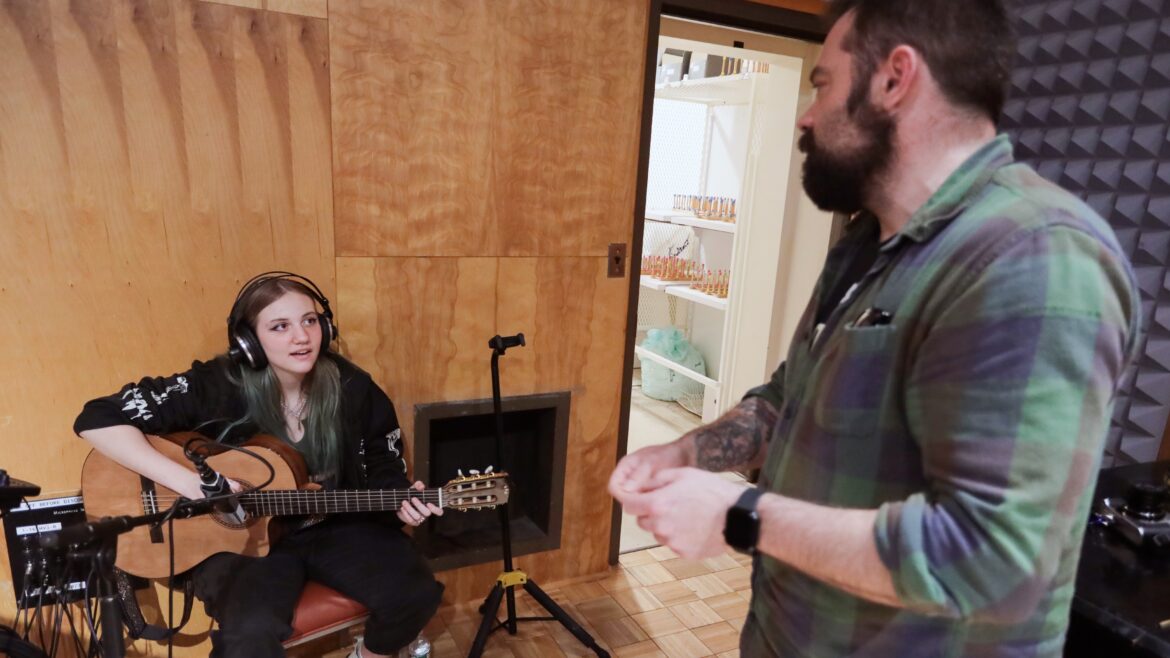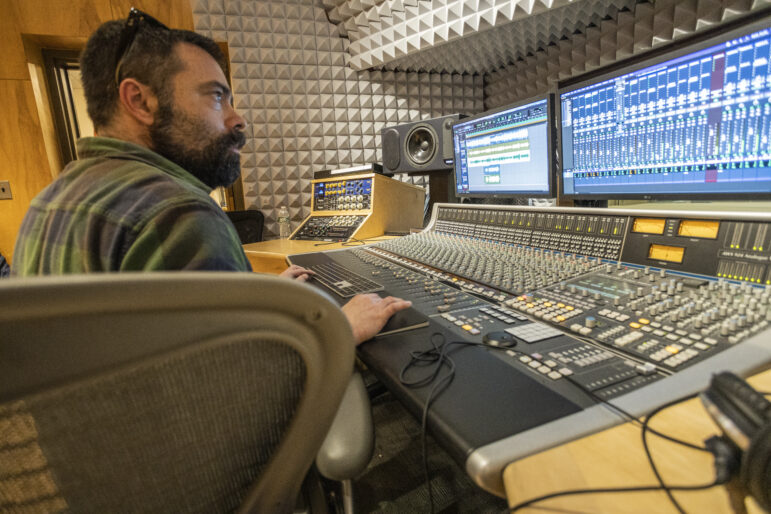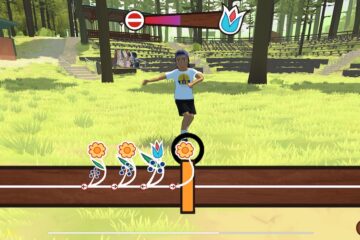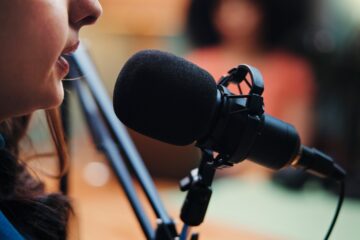How a WAER collaboration with young musicians spawned original content and a ‘haunting’ tune

Dylan Suttles
Syracuse musician Mira Grimm, 15, with Jim Elenteny, a professor of sound recording technology at Syracuse University, in the university's Belfer Audio Lab.
Sometimes, just sometimes, our jobs can be fun.
Six months ago, when Syracuse University reassigned me from a community newspaper project to work at its public radio station, the station’s content manager encouraged me to pitch programming ideas. My initial thought was a project that would create new content, appeal to a wide audience, highlight community members and incorporate contributions from students.
I conceived what would be called Salt City Mashup, which would air on WAER 88.3 FM and appear on the station’s website. Around the station, it became known as “the musician mashup.” The premise: Bring together young musicians to write, record and produce a new song in a limited time frame. We would record the process, pull together highlights, profile each musician and include their reflections. The project would end with a grand release of the final song.
It would also be fun and check off all the boxes the station wanted fulfilled. Radio gold.

My colleagues greeted the idea with excitement. My new supervisor at WAER, the content manager, supported the project by ensuring I had time each week to work on it. The station’s development office showed enthusiasm as it considered underwriters the project could attract. In the end, the general manager gave the final signoff, and I had the green light to proceed.
Other stations can replicate this idea by devoting a few hours of planning each week, carving out time for two days in the studio, and enlisting a talented audio producer to pull the piece together. As a bonus, they’ll be a catalyst to a new song entering the world.
From idea to completion, the project took about four months. I was new to audio editing, so it took a few weeks for me to produce the final audio mix. Others with more editing talent may require less time.
To get started, I sketched out a timeline for the idea. First, we would request nominations and confirm partnerships and student support. This was done over a month, spending a bit of time each week to coordinate and follow up with people to be involved.
Getting it together
Once the key players are in place, follow these steps to recreate a similar collaborative session:
• Assemble the team. Gather a diverse group of musicians across different generations and genres. Look for individuals with different backgrounds and experiences to bring a unique blend of creativity to the project.
• Find a mentor and partners. Enlist the help of a seasoned musician well-known in the community who can provide guidance and valuable insights throughout the collaborative process. For partners, consider working with a local music school or studio for resources and expertise. This can provide access to professional equipment, larger spaces and mentorship from music industry experts.
• Set a timeline. Establish a clear timeline for the project both to meet deadlines and for logistic purposes. Plan how to document the process through videos, photos and interviews and how you’ll use those materials to promote the final project on air, online and on social media.
• Make it happen. Bring together all of the participants to spark ideas. Once the song is complete, share through online platforms, social media, local music events and community outlets. Participants in our project appeared on a local TV morning show.
Five Syracuse musicians came up with “That’s My Luck,” a haunting and smoky tune that incorporated their styles and talents. Mira Grimm, 15, sang lead vocals and played guitar. Up-and-coming working musicians Marcus Oliver on drums and Cooper Francis on guitar rounded out the sound. Syracuse music veteran Joe Driscoll provided guidance, and recent high-school graduate Ayman El-Hindi delivered a whistle that became the song’s signature.
For your station, the top benefit of such a project is creating original content. At WAER, we discussed launching this first special and then using it as an example for future grant pitches. It could also attract local underwriters.
We featured young musicians because we had no funding to pay contributors for their time. Expose and the experience of working with a mentor, we thought, would serve as the incentive to participate. But a grant would help cover other costs, such as studio space if your station lacks a partner with a music studio. WAER will use future grants to pay professional local musicians.
Another consideration is the rights to the use of the final music. Our station’s content manager created a form allowing WAER to air the song, and the musicians agreed to include the song in a YouTube video to share widely. Using young musicians created another small hurdle. Because Grimm was under 18, we created a minor release form for her parents to sign allowing for her participation.
By following this guide, your station can create a collaborative music session that brings together musicians of different generations and backgrounds to create a unique and memorable song. Remember that the journey itself is just as important as the final outcome, as it’s a testament to the power of musical collaboration and shines a light on local talent in your coverage area.
Ashley Kang produced Salt City Mashup for Syracuse University’s WAER 88.3 FM. She also serves as the lead educator for the Syracuse Journalism Lab. Email her at akangwords@gmail.com.






